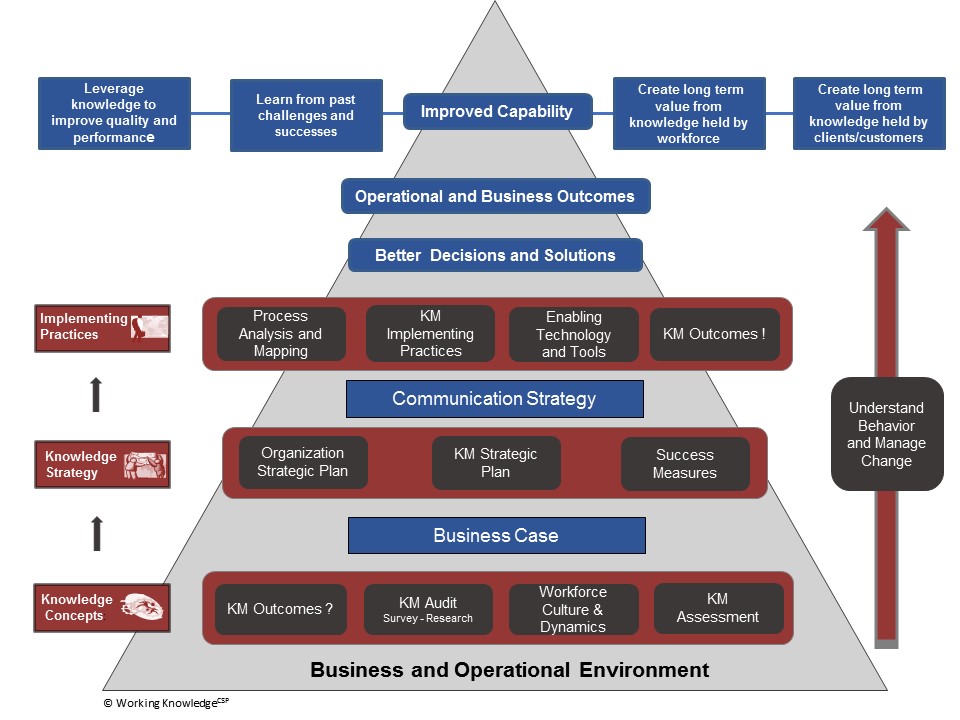
Outcomes based on requirements = Know where you’re going and why before you start!
One could maintain that KM is about “creating value from your knowledge to improve performance at the individual, team, and organization level to drive mission success.”
For any major project or process, common sense and sound buisness judgement dictate the necessity to plan — to think through the “who, why, what, how, and when.” This is especially true involving knowledge management projects. Planning, developing, and implementing a sustainable KM Strategy and developing a KM Framework to implement that strategy requires you understand why you are undertaking a KM project and what outcome(s) you want when the KM project is completed.
The practice-based Concept-Strategy-Practice (CSP) Model shown above was developed from lessons learned from 20 years of consulting engagements and KM projects as (1) a Chief Knowledge Officer for a mid-cap consulting company and (2) from consulting engagements supporting private sector, federal and state governments, and international clients.
The CSP model is a proven and logical methodology not only for thinking through KM planning and implentation, but also sustaining the outcome. The Working KnowledgeCSP CSP Model helps you to focus on:
- easily stated and easily understood outcomes
- tied to select measures of (KM) success
- tracked to existing strategic initiatives and measures of value.
Each phase focuses on a critical component for success.

Knowledge Concepts: Developing a concept for KM in your organization based on your desired outcomes, identification of what is critical and relevant knowledge, the culture of your organization, and an assessment of your KM maturity, your readiness to take on a KM investment.

Knowledge Strategy: Understanding the strategic plan of the greater organization of which you are part and the ensuring that the business case for KM investment over the longer term can be made. This includes developing a KM strategic plan that is linked to the overall strategic plan of the organization to ensure that there is funding and resources to sustain the investment. Most importantly, we help you to identify meaningful measure of success that you use not only to measure the progress of your KM program, but also the value (return) it provides to help to ensure continued funding and resource support.

Implementing Practices: Your KM implementation should be based on your unique environment and desired outcomes…what makes sense in your context. Previous insight gained from Phase 1 and Phase 2 provides the necessary baseline to develop a framework that fits your organization and its unique goals and desired outcomes.
![]()

Download an explanation of the CSP Model
Concept | Strategy | Practice | (CSP) Model
Knowledge Concepts
KM Outcomes: What do you want to happen as a result of investing in and resourcing KM? What changes are you focused upon achieving, near term and longer term? Why are you seeking change?
KM Audit: What are your organization’s knowledge needs, gaps and opportunities in four key areas?
- Current levels of knowledge usage and communication
- Current state of corporate knowledge management
- Identification and clarification of knowledge management opportunities
- Identification and clarification of potential knowledge problem areas
Workforce Culture and Dynamics: What is the underlying workforce culture and dynamics of your organization? Will it have a positive or negative impact on the success of any investment in KM or KM project?
KM Assessment: How “ready” is your organization to “make the changes” necessary to implement a performing and learning approach to knowledge capture, retention, and reuse that is part of the way you work? There are six elements in the Working KnowledgeCSP assessment model.
The KM Business Case – Link between Concept and Strategy: Your KM effort can have a significant and positive impact on the performance and success of the entire organization if you can get the larger organization to see the value in your proposed efforts. Your business case must tie a knowledge management investment to business, operational, or mission outcomes.
Knowledge Strategy
Align with the Organization’s Strategic Planning: How do you align and make your KM Strategy an integral part of the strategic planning of the organization? An investment in knowledge management must have a strategic orientation in that all KM activities tie directly into and support overall organization goals.
KM Strategic Plan: What are the objectives of the KM strategy and what are the goals which are necessary to achieve these objectives? How do you tie this to a business benefit or outcome?
Measures of Success: What are the most meaningful measures of success for your KM efforts and how are they tied to your KM Strategic Plan, and ultimately, the strategy for your organization? Measures of success can take many forms and serve many purposes.
Communication Strategy: Since all KM projects are also change management efforts, how are you going to communicate the value of the change driven by the KM effort. In delivering change, how are you going to effect change in individual, team, and organization behavior? What is the messaging? What are the tools that will be available to communicate change and value?
Implementing Practices
Pilot Projects: Validating, through carefully selected pilot projects, the relevant KM practices, tools, and techniques that you will embed in your organization as “part of the way you work;” Demonstrating that the strategy you developed and are implementing will be a fit for your organization and be sustainable over time.
Critical and Relevant Knowledge: What is the critical and relevant knowledge (information + experience) that is necessary and fundamental to achieving the desired mission outcome?
Process Management: What are your processes and can you “see” them? Before you can improve what you are doing, you need to see what it is that “you are doing”… a knowledge enabled process map.
Change Management (Behavior Change): What approach to introducing KM and implementing practices fits your organization due to the unique workforce dynamics and culture of your organization? How will you integrate the communication strategy? How you will enable the environment that facilitates change?
KM Outcomes: Are you achieving your desired outcomes? How do you know?

